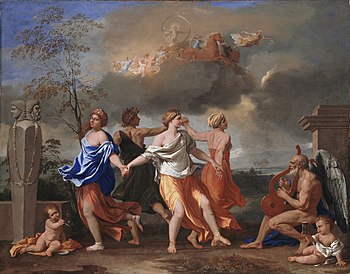A Dance to the Music of Time (painting)
| A Dance to the Music of Time | |
|---|---|
 | |
| Artist | Nicolas Poussin |
| Year | 1634–1636 |
| Medium | Oil on canvas |
| Dimensions | 82.5 cm × 104 cm (32.5 in × 41 in) |
| Location | Wallace Collection, London |
A Dance to the Music of Time is a painting by
The painting is well known for giving its name to the A Dance to the Music of Time novel cycle, though this title is first seen in a Wallace Collection catalogue of 1913. Before that it was given titles referring to the Four Seasons. In the 1845 sale it was called La Danse des Saisons, ou l'Image de la vie humaine.[2] The Bibliothèque nationale de France lists it with three different French titles.[3]
Description
There are four figures, holding each other by the hand, dancing in a circle, as Time plays a lyre on the right. The scene is set in the early morning, with Aurora, goddess of dawn, preceding the chariot of Apollo the sun-god in the sky behind; the Hours accompany him and he holds a ring representing the Zodiac.
According to
These identifications are disputed by Malcolm Bull, at least as the original intention. He traces the
There are several
The painting is in generally good condition, but has been retouched in places, including over the repair of a large L-shaped tear running right through the central group.[10]
Anthony Powell
At the start of Anthony Powell's series of novels named after the painting, the narrator, Nicolas Jenkins, reflects on it in the first two pages of A Question of Upbringing:
These classical projections, and something from the fire, suddenly suggested Poussin's scene in which the Seasons, hand in hand and facing outward, tread in rhythm to the notes of the lyre that the winged and naked greybeard plays. The image of Time brought thoughts of mortality: of human beings, facing outward like the Seasons, moving hand in hand in intricate measure, stepping slowly, methodically sometimes a trifle awkwardly, in evolutions that take recognisable shape: or breaking into seemingly meaningless gyrations, while partners disappear only to reappear again, once more giving pattern to the spectacle: unable to control the melody, unable, perhaps, to control the steps of the dance.
Provenance
It passed from the Rospigliosi family to the Joseph Fesch collection in 1806, when it was taken to France for a period. It was then bought, along with several other paintings, by Richard Seymour-Conway, 4th Marquess of Hertford, in the great Fesch sale in Rome in 1845. It then passed to his son, Sir Richard Wallace. It was exhibited in the Art Treasures Exhibition, Manchester 1857.[11]
See also
Notes
- ^ Wallace. The date is purely based on style, and Ingamells, 310 thought "1639-40 or perhaps slightly earlier".
- ^ Ingamells, 311
- ^ "Titre conventionnel: La Ronde sur la musique du Temps". BNF.
- ^ Ingamells, 309-310; Wallace
- ^ Ingamells, 309-310
- ^ Bull, 258
- ^ Bull, 258-259
- ^ Bull, 260
- ^ Ingamells, 310
- ^ Ingamells, 307-309
- ^ Ingamells, 311
References
- Bull, Malcolm, The Mirror of the Gods, How Renaissance Artists Rediscovered the Pagan Gods, Oxford UP, 2005, OCLC 680610591
- Ingamells, John, The Wallace Collection, Catalogue of Pictures, Vol III, French before 1815, London: Wallace Collection (1989) OCLC 902220050(online via museum - PDFs under "Images" tab)
- "Wallace": Wallace Live - catalogue entry
Further reading
- Beresford, Richard, A Dance to the Music of Time. London: Wallace Collection (1995) OCLC 715929402
